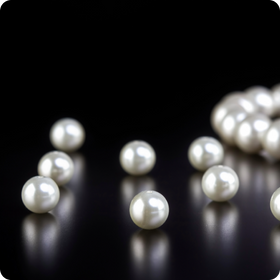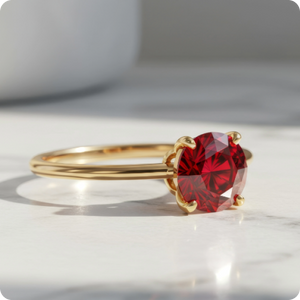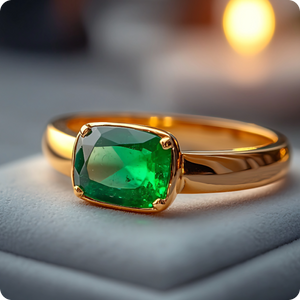Every civilization has treasured gemstones alike. And amongst all precious gems, there's one that's the most delightful - emerald stone. Emerald, also known as Panna Stone, is one of the most coveted stones ever. The stone's alluring vivid green color and brilliance cast a spell on the heart of every person. Besides the jewelry industry, this gem holds a significant place in the astrology realm.
Panna's use in fashion jewels and astrology has made it a sought-after valued gem. Its rarity and high market demand have led to synthetic emeralds. Buyers find it hard to differentiate between natural and synthetic Panna.

In this blog, we will explore all you need to know about lab-created emerald vs natural emerald. We hope this will help you choose the best emerald match for you. Let's get started!
Discover the Beauty of Natural Emerald
Emerald is a precious gemstone part of the big four alongside diamond, ruby, and sapphire. It's also in the nine gems known as Navratan. Panna's beauty, history, folklore, and astrological significance make it desirable.
Panna Stone was mined as early as 330 BC in Egypt. Some experts roughly calculate that an old emerald can even be 2.97 billion years old. Cleopatra, the queen of Egypt during 51–30 BCE, is a popular historical figure who adored these green gems. The queen even claimed ownership of all Panna mines in Egypt during her sovereignty.
Emeralds in jewelry and burials in Egypt were common. Monarchs were protected with this stone. Colombia also had hidden emerald Muzo mines. Spanish conquerors took 20 years to find these sources.
Today, Panna symbolizes love, loyalty, peace, and security. Emerald is lucky for Gemini and Virgo natives per Vedic astrology. Taurus, Libra, Capricorn, and Aquarius can also wear it.
Discover the benefits of wearing emerald gemstones. Enhance skills, prosperity, wisdom, creativity, marital bliss, and health. Learn quick facts about Panna Stone.
Quick Facts About Natural Emerald Stone
- The name "emerald" comes from "Smaragdus", which is a Greek word.
- As per Wikipedia, most emeralds come from Colombia.
- Natural emeralds are rarer than diamonds, and sometimes even more expensive.
- Unlike other stones, panna stones are valued for their inclusions like "Jardins."
- Ancient folklore associates this stone with clairvoyance, the ability to foresee the future.
- One of the largest uncut emeralds is the "Duke of Devonshire Emerald."
Read Also - Top 10 Benefits of Wearing Emerald Stone (Panna)
Types of Natural Emerald
Emeralds can be of different types coming from distinct parts of the world. Here are some of the most famous Panna stone types below.
- Colombian emerald
- Zambian emerald
- Pakistan emerald (Swat Valley emerald)
- Afghanistan emerald (Panjshir emerald)
- Brazilian emerald
- Ethiopian Emerald
Synthetic Emerald - A Manmade Creation
Synthetic or artificial emeralds are man-made gems. Natural emeralds are rare and expensive. Brands produce artificial ones due to scarcity. W. Zerfass and Jaeger led the synthetic emerald project for over 2 decades (1952–1973) for success.
The process of growing Panna stones in a lab is identical to how they grow in nature. They are made using the same chemical composition, chemistry and trace elements. Man-made emeralds exhibit crystal structure, color, and appearance like a natural one. Even a seasoned gem expert will struggle to distinguish between the two from a distance.
When comparing synthetic and natural Panna stones, their prices can vary significantly. Artificial stones lack the value retention of natural ones and can be more transparent. Synthetic emeralds can be customized to suit a client's preference.
Let's look at some quick facts about synthetic Panna stones below.
Quick Facts About Synthetic Emerald
- The first artificial emerald was created in the year 1935.
- One can create them whenever they want.
- Artificial emeralds don't hold their value like natural ones.
- When it comes to synthetic gems, emeralds are one of the most difficult stones to produce.
- Extra-large emeralds can take up to one year or more to develop.
- Artificial emeralds are usually used for jewelry making.
Also Read: An Expert Guide on How to Tell If an Emerald Stone Is Real
How are Emeralds Created?
How are emeralds created in a lab? Synthetic emerald stones copy the look of natural ones using specific methods. Learn about the processes for creating Artificial Panna.
Flux Emerald
Emeralds are created by diffusing elements in a heated flux solution in a platinum crucible. The emerald growth process can take months, with larger stones requiring more time to develop.
Only flux emeralds can contain platinum platelets. Developed by French chemist Jacques Joseph Ebelman in 1848, the flux process is costly compared to mining emeralds.
Hydrothermal Emerald
Next, explore the hydrothermal process and discover what a hydrothermal emerald is. This method replicates the natural conditions where emeralds form, mimicking the heat and pressure of the deep earth. Through the dissolution of elements in a solution, synthetic crystals are created.
Panna stones have unique features like nail-head spicules and emerald inclusions such as tubes and fingerprints. The main difference is their elongated hexagon shape instead of irregular ones.
Let's look at the major properties of flux and hydrothermal emeralds below.
Read Also - 7 Health Benefits of Emerald Gemstone: You Should Know
| SL.NO | Properties | Flux Emerald | Hydrothermal Emerald |
| 1 | Refractive Index | 1.570 | > 1.570 |
| 2 | Density | 2.65 – 2.67 | 2.67 – 2.71 |
| 3 | Inclusion | Flux, feathery veil-like healed crevices, two stage inclusion – remaining flux with contraction bubbles & platinum | Chevron-like growth, Neal-heal spicules, wavy growth structure & phenakite |
A Comparison between Lab Created Emerald Vs Natural Emerald
Now that we know the ins and outs of natural and synthetic emeralds, let's understand how to compare the two. Both stones might seem similar in composition, but they do differ in color and clarity. Natural emerald stones exhibit a deep, rich and saturated green color. Most of them have a blue-green or yellow-green tint.
The most valuable emeralds have little to no tint. Natural ones have a dark color tone and a brilliance that emits a green glow when light passes through. Natural impurities make this stone glow. Artificial emeralds do not emit a green glow.
Man-made emeralds vary in color and lack inclusions, believed to be flaws by some. In reality, these inclusions are unique characteristics of Panna, signifying purity and authenticity. Consider appearance-enhancing treatments on Panna. Identifying real vs. artificial emeralds involves noting color and saturation differences.
Here's how you can distinguish between a lab-created emerald vs natural emerald.
Read Also - Top 10 Things You Must Check Before Buying An Emerald Stone
How to Identify a Lab Created Emerald Vs Natural Emerald?
To determine if your emerald is real or man-made, consider key factors to aid identification. Factors may pose challenges for buyers, so we provide pointers to assist. Explore the crucial factors below.
Treatment: Emerald is usually oil-treated to enhance its clarity, durability and stability. A Panna stone with no enhancements or treatment is rare.
Price: This green stone is one of the most sought-after gemstones which leads to its high price tag. It's essential to check the quality and price of emerald stone before buying.
Inclusions: Panna is a type III gemstone, meaning it includes characteristic inclusions. The inclusions result from gas, liquid and the presence of other minerals. Finding an inclusion-free emerald gemstone is exceptionally rare.
To ensure your Panna stone is natural, it's best to ask for an authenticity certificate from the seller. A certificate from a reputed gemological laboratory determines the stone's authenticity. Buyers should be able to tell the difference between real and fake emerald certificates. Also, they should always verify the physical features of Panna from the gem experts.
To check whether the certificate is genuine or not, verify your report number on the gem lab certificate company website.
Buy 100% Natural Emerald at GemsRoot
Purchase a genuine emerald from a trusted source like GemsRoot for a wide range of natural, ethical, and lab-certified gemstones. Receive original GRS certificates with each stone.
You can check our exquisite natural emerald stone collection online on our website. You can also talk to our gem experts for gem advice based on your date of birth and birth chart. Our consultants offer 24x7 customer support striving to provide the best service possible. For accurate gem recommendations, contact our gem experts today!
Buy genuine and certified emeralds at the most trusted panna stone price at GemsRoot, ensuring authenticity and value with every purchase.





